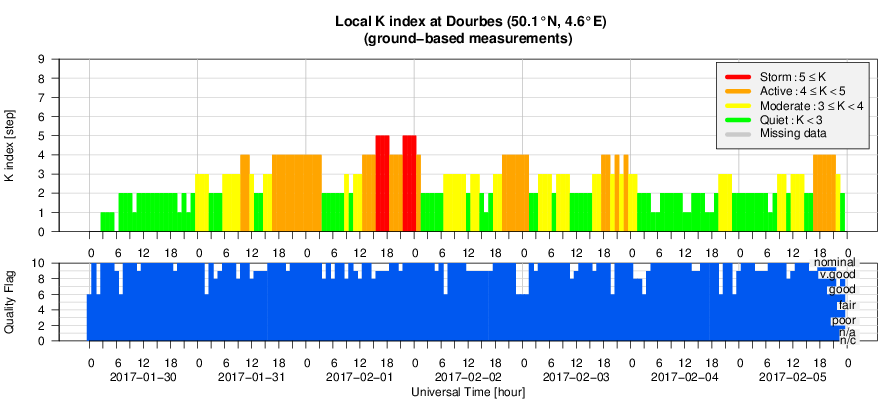- Table of Content
- 1.Nelson, 12y as...
- 2.Geomagnetic st...
- 3.PROBA2 Observa...
- 4.Review of sola...
- 5.The Internatio...
- 6.Geomagnetic Ob...
- 7.Review of iono...
- 8.Future Events
2. Geomagnetic storms and solar eruptions
3. PROBA2 Observations (30 Jan 2017 - 5 Feb 2017)
4. Review of solar and geomagnetic activity
5. The International Sunspot Number
6. Geomagnetic Observations at Dourbes (30 Jan 2017 - 5 Feb 2017)
7. Review of ionospheric activity (30 Jan 2017 - 5 Feb 2017)
8. Future Events
Nelson, 12y asks 'How does the house of the ISS look like?'
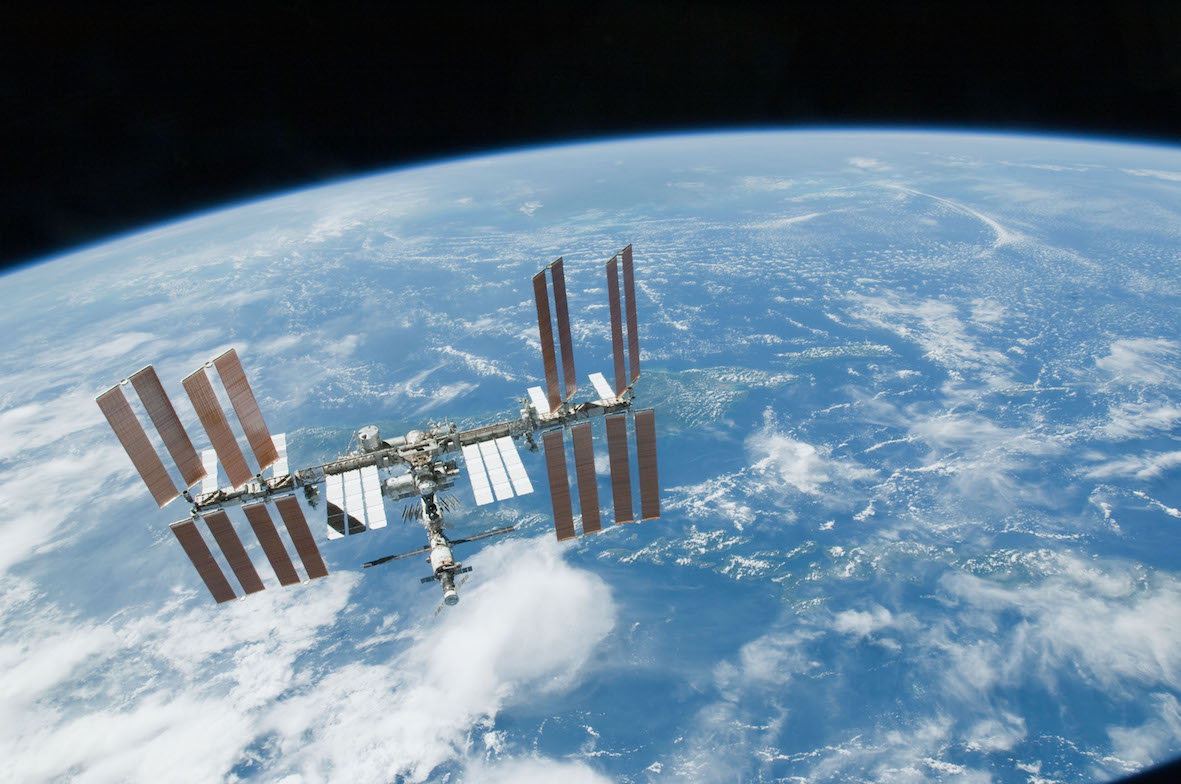
How does the floor plan of the International Space Station looks like? Where is the bathroom, toilet, bedroom, gym, …? Are they connected with corridors? Is there a first floor, second floor, third floor?
A scientist answers
Dear Nelson
This picture shows the configuration of the International Space Station (ISS):
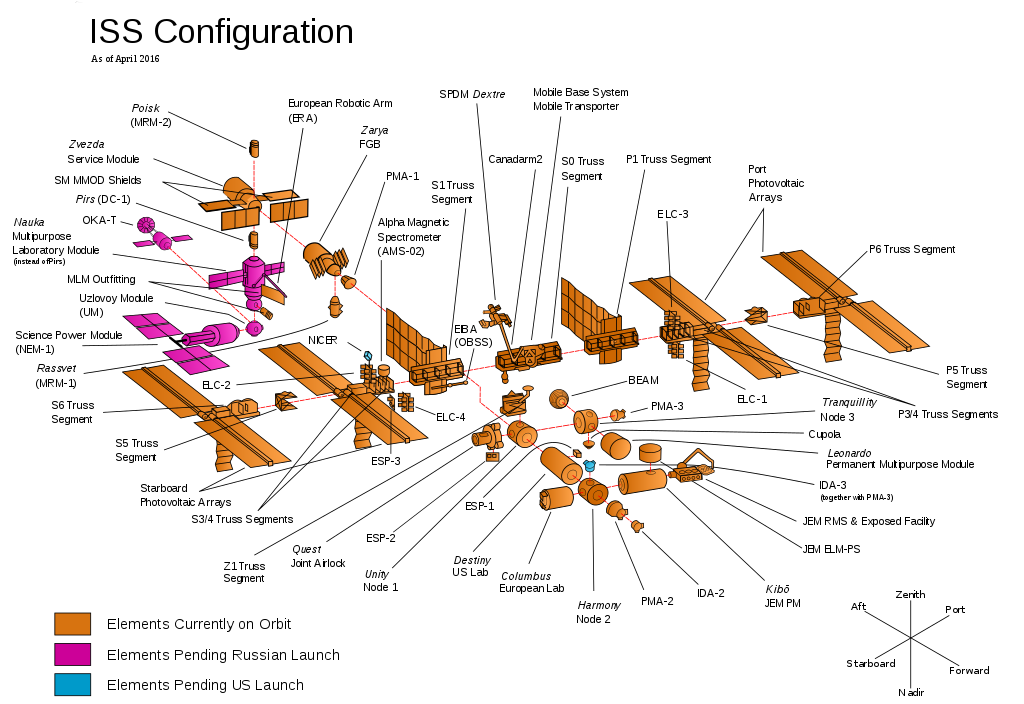
You can find it on Wikipedia.
There is also a movie in which an astronaut guides you through the ISS. The images are great and give you an idea: https://www.youtube.com/watch?v=WkYz43qALMU
More really cool stuff: http://esamultimedia.esa.int/multimedia/virtual-tour-iss/
Have fun!
Stijn Calders, STCE
This question is from https://www.ikhebeenvraag.be , a website where you can ask a question. Scientists give the answer.

Geomagnetic storms and solar eruptions
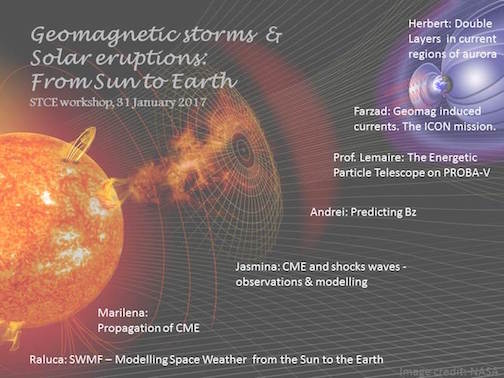
the STCE Workshop "Geomagnetic storms and solar eruptions: from Sun to Earth" took place in the cozy meeting room of the RMI. Thirty-nine (39!) participants got submerged in the modeling of drivers of geomagnetic storms and solar storms as well as their impact on the geospace environment. The workshop was chaired by Dr Véronique Delouille (ROB), and consisted of 7 talks each followed by a few minutes of Q and A.
The presentations are now online: https://events.oma.be/indico/event/21/
PROBA2 Observations (30 Jan 2017 - 5 Feb 2017)
Solar Activity
Solar flare activity remained very low during the week.
In order to view the activity of this week in more detail, we suggest to go to the following website from which all the daily (normal and difference) movies can be accessed: http://proba2.oma.be/ssa
This page also lists the recorded flaring events.
A weekly overview movie can be found here (SWAP week 358):
http://proba2.oma.be/swap/data/mpg/movies/weekly_movies/weekly_movie_2017_01_30.mp4
Details about some of this week’s events, can be found further below.
If any of the linked movies are unavailable they can be found in the P2SC movie repository here:
http://proba2.oma.be/swap/data/mpg/movies/
Wednesday Feb 1

A coronal hole in the southern hemisphere dominated the solar disk at the start of the week. This is clearly seen on 2017-Feb-01. Find a movie of the event here (SWAP movie):
http://proba2.oma.be/swap/data/mpg/movies/20170201_swap_movie.mp4
Saturday Feb 4
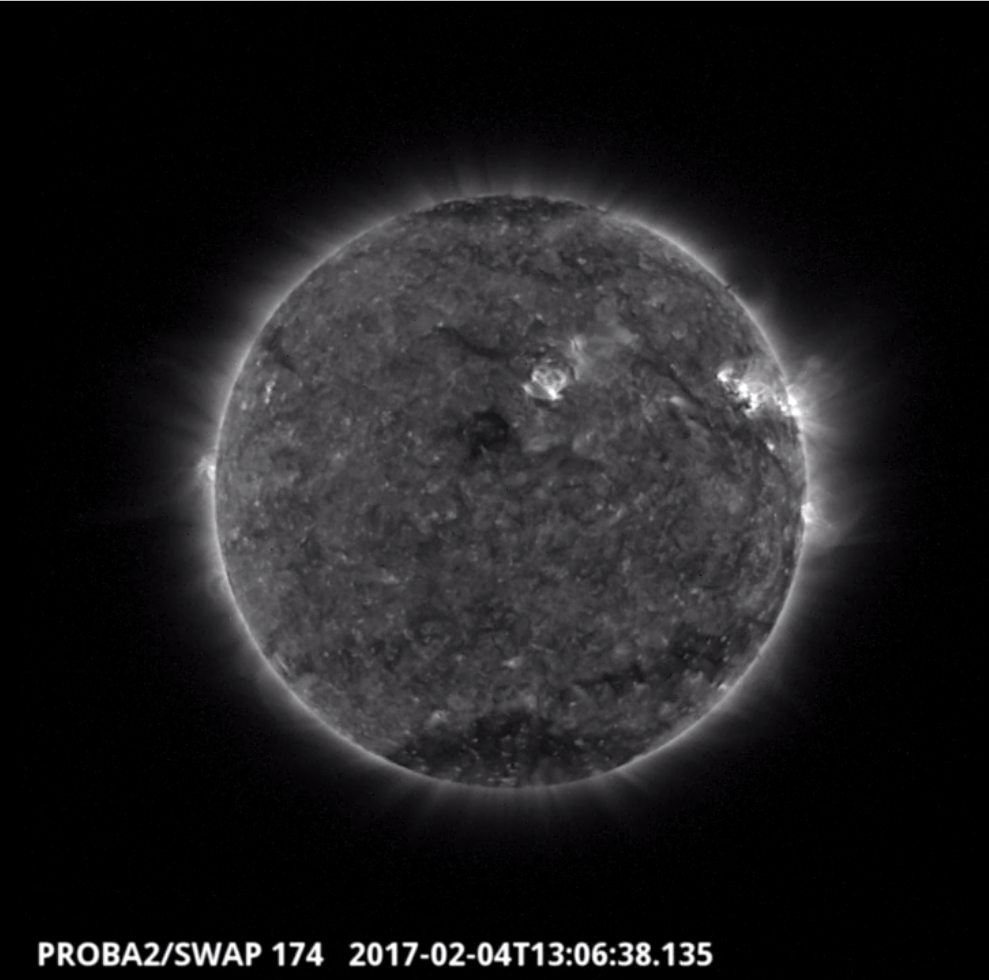
The active region that produced the largest flare of the week (B1.6 class flare) is shown here in the North-West of the Sun on 2017-Feb-04 at 13:06 UT. Find a movie of the events here (SWAP movie):
http://proba2.oma.be/swap/data/mpg/movies/20170204_swap_movie.mp4
Review of solar and geomagnetic activity
Solar Activity
Solar activity was very low. The largest flare recorded was a B1.6 class flare produced by Active Region (AR) 2632. Solar protons have remained at background levels over the past week. No Earth directed Coronal Mass Ejections (CMEs) have been detected. A partial halo CME was visible from 15:24 UT onwards on 2017-Feb-01. The ejection was mostly directed towards the North and had an angular extent of approximately 150 degrees. The speed was measured to be approximately 250 km/s. The source region was unclear but believed to be back-sided. The CME is not expected to hit the Earth. A large negative polarity trans-equatorial coronal hole extending from the Southern pole dominated the solar disk throughout the week.
Geomagnetic Activity
The solar wind speed has fluctuated between 380 and 800 km/s over the past week. The total magnetic field strength has fluctuated between 5 and 17 nT peaking on 2017-Jan-31. The Bz component fluctuated between -12 and +9 nT. Geomagnetic conditions ranged between Kp index 1-5 (NOAA) and local K index 1-5 (Dourbes) over the past week. The occasional active conditions experienced by the Earth were created by the large trans-equatorial coronal hole, and the associated Co-rotating Interaction Region (CIR). The High-Speed Stream (HSS) associated with the hole reached speeds of 800 km/s, and enhanced Geomagnetic activity.
An running presentation can be downloaded here: http://www.stce.be/movies/Forecasting_30_Jan_2017.ppsm
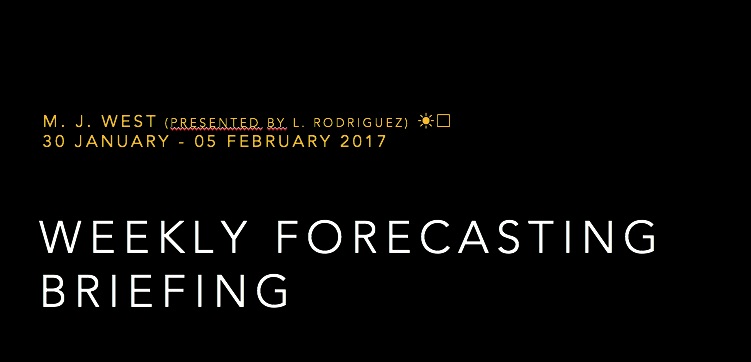
The International Sunspot Number
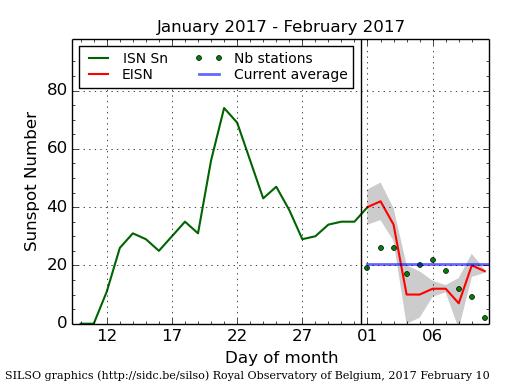
The daily Estimated International Sunspot Number (EISN, red curve with shaded error) derived by a simplified method from real-time data from the worldwide SILSO network. It extends the official Sunspot Number from the full processing of the preceding month (green line). The plot shows the last 30 days (about one solar rotation). The horizontal blue line shows the current monthly average, while the green dots give the number of stations included in the calculation of the EISN for each day.
Review of ionospheric activity (30 Jan 2017 - 5 Feb 2017)
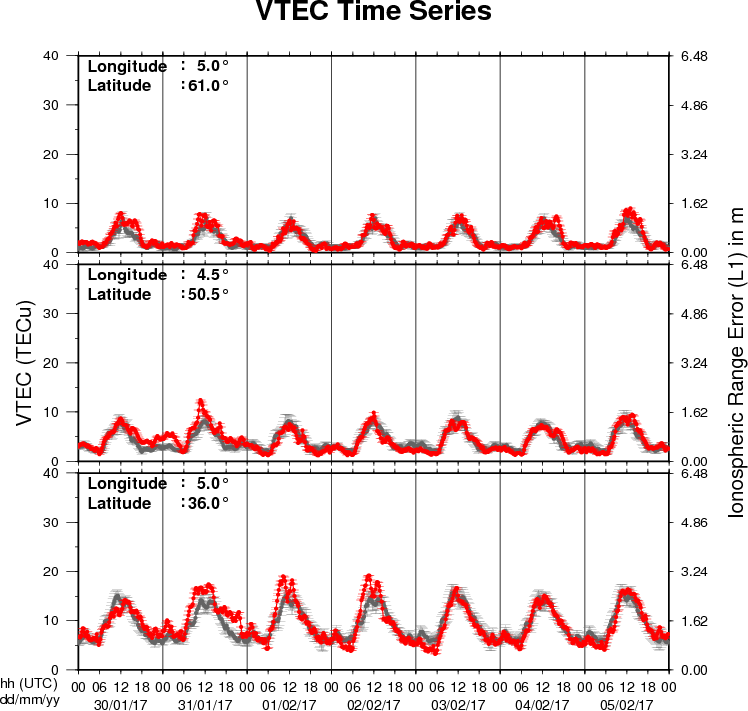
The figure shows the time evolution of the Vertical Total Electron Content (VTEC) (in red) during the last week at three locations:
a) in the northern part of Europe(N61°, 5°E)
b) above Brussels(N50.5°, 4.5°E)
c) in the southern part of Europe(N36°, 5°E)
This figure also shows (in grey) the normal ionospheric behaviour expected based on the median VTEC from the 15 previous days.
The VTEC is expressed in TECu (with TECu=10^16 electrons per square meter) and is directly related to the signal propagation delay due to the ionosphere (in figure: delay on GPS L1 frequency).
The Sun's radiation ionizes the Earth's upper atmosphere, the ionosphere, located from about 60km to 1000km above the Earth's surface.The ionization process in the ionosphere produces ions and free electrons. These electrons perturb the propagation of the GNSS (Global Navigation Satellite System) signals by inducing a so-called ionospheric delay.
See http://stce.be/newsletter/GNSS_final.pdf for some more explanations ; for detailed information, see http://gnss.be/ionosphere_tutorial.php
Future Events
For more details, see http://www.spaceweather.eu/en/event/future
International CCMC-LWS Workshop in Cape Canaveral, Florida (USA)
Start : 2017-04-03 - End : 2017-04-07
The goal of this working meeting is to address the need to
quantify and to track progress over time in the field of space
weather and to establish internationally recognized metrics that
are meaningful to end-users and developers. Defining a set of
appropriate metrics is important to track advancements in space
weather understanding and predictive capabilities.
This meeting is a part of the unfolding activities of the
International Forum for Space Weather Capabilities Assessment that
brings together space environment experts, model and application
developers, data providers, forecasters and end-users. The goals of
this community-wide forum include addressing challenges in
model-data comparisons and evaluating the current state of space
environment predictive capabilities. Workshop attendance is
encouraged but is not a requirement for joining forum teams.
Website:
http://ccmc.gsfc.nasa.gov/CCMC-LWS_Meeting/
Solar Orbiter Workshop 7: Exploring the solar environs in Granada, Spain
Start : 2017-04-03 - End : 2017-04-06
This event will be hosted by the Instituto de Astrofisica de
Andalucia - CSIC. Please mind that on April 7th the 20th SWT
meeting will take place at the same venue.
Website: Unkown
URSI General Assembly in Montreal, Canada
Start : 2017-08-19 - End : 2017-08-26
For the thirty-second time since the inception of URSI, Radio
Scientists from across the world will get together for the URSI
General Assembly and Scientific Symposium. This triennial gathering
will take place from 19th to 26th of August 2017, in Montreal,
Canada. This conference is a unique opportunity to learn about
recent advances in all fields of Radio Science, as covered by all
ten URSI Commissions.
Among the different sessions, please note:
* 'Radio Science for Space Weather'
Conveners: M. Messerotti, V. Pierrard
* 'Remote Sensing and Modeling of the Earth's Plasmasphere
and Plasmapause'
Conveners: A. M. Jorgensen, V. Pierrard, B. Heilig
The abstract deadline is 30 January 2017
Website: http://www.ursi2017.org
2017 Joint IAPSO-IAMAS-IAGA Assembly in Cape Town, South Africa
Start : 2017-08-27 - End : 2017-09-01
The Local Organising Committee is thrilled to welcome you to the
2017 Joint IAPSO-IAMAS-IAGA Assembly in Cape Town, South Africa.
The Joint Assembly, endorsed by the University of Cape Town and the
South African Department of Science and Technology, will take place
from 27 August to 1 September 2017 at the Cape Town International
Convention Centre (CTICC).
Website:
http://iapso-iamas-iaga2017.com/index.php
Workshops on Radiation Monitoring for the International Space Station in Torino, Italy
Start : 2017-09-05 - End : 2017-09-07
The Workshop on Radiation Monitoring for the International Space
Station is an annual meeting to discuss the scientific definition
of an adequate radiation monitoring package and its use by the
scientific community on the ISS. Types of instruments and research
topics need to be defined in order to optimise the radiation safety
of the ISS crew.
Website: http://wrmiss.org/
European Space Weather Week 14
Start : 2017-11-27 - End : 2017-12-01
The ESWW is the main annual event in the European Space Weather
calendar. It is the European forum for Space Weather as proven by
the high attendance to the past editions. The agenda will be
composed of plenary/parallel sessions, working meetings and
dedicated events for service end-users. The ESWW will again adopt
the central aim of bringing together the diverse groups in Europe
working on different aspects of Space Weather.
Website:
http://www.stce.be/esww14/
